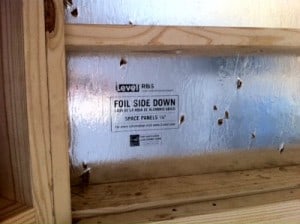Is there a top or bottom, are both sides the same?
For the double-sided products, both sides are the same. For the single-sided products, the foil side faces the air space/gap.
Will the AtticFoil™ aluminum radiant barrier oxidize & show signs of corrosion over time?
In short, NO. When aluminum reacts with oxygen in the air, it produces an organic aluminum-oxide barrier via a process called passivation. This layer protects the metal’s surface from oxidizing and therefore the product will resist corrosion. Additionally, this protective layer does nothing to diminish the foil’s ability to reflect radiant heat so you have a superior heat barrier that will stand the test of time.
Read more: Oxidation of Aluminum Foil Reflective Radiant Barrier Insulation
Additionally, we have several samples of product in testing that have been exposed outside to the elements, undisturbed for 4+ years and none have shown signs of corrosion or a decrease in reflectivity. If those are results from pieces outside and unprotected, you can be confident that inside an attic or a wall the conditions are even better. More info here: http://www.rimainternational.org/index.php/technical/tb-index/tb105/
What is the advantage of using a heavyweight radiant barrier foil?
Both the lightweight and the heavyweight radiant barrier foils have the same reflectivity quality; the difference is the lightweight products can tear easily. Atticfoil.com only sells the heavyweight foil because it is virtually tear-proof and will never rip or sag in your attic. One loose critter in your attic can easily knock down all the foil if you use a lightweight product.
I keep reading you must have an air space for radiant barrier to work. Why?
This is probably the most misunderstood requirement for a radiant barrier to work. Watch this video, hopefully this will make it all clearer and easier to understand.
I went to a presentation and they called the foil something else. Is this the same stuff?
It might be. To be totally honest, we sell to home owners and many professional installers. Some installers “re-label” or “brand” the foil. The best way to compare products is to get a FREE SAMPLE of our radiant barrier and compare it with the product in question.
Isn't Bubble Foil better?
The bubble foil is a good product and has many uses; however, bubble foil insulation is often overused in residential attics. It works, but it is the foil doing the work and not the bubbles in a ventilated attic. Add to that the fact that bubble products cost a lot more and bubble foil products do not allow water vapor through, often creating an unintended vapor barrier.
Read about theDifference between Bubble Foil, eShield, Prodex and other products compared to Attic Foil™.
Some companies sell laser-perforated foil. Is there a difference?
We don’t know of any company that makes laser perforated foil, but somehow it’s in the market? It sounds really high-tech and advanced, but here is the deal: we are talking about a bunch of little holes. Do you really care how the holes (perforations) are made, or just that they are there?
Is this the same stuff that was developed by NASA?
NASA did develop radiant barrier technology; however it has been a public domain technology since the 1970’s.
Radiant barrier technology is used in thousands of products today, like candy wrappers, potato chip bags, oil rig fire fighting suits, thermos bottles, emergency fire shelters, and construction and insulation materials. Yes, NASA technology is used in all radiant barriers, but this is not the actual stuff used by NASA.
Can drywall be applied on top of the foil?
Only if there is an air gap in the assembly; typically the air gap would be between the outer layer and the foil layer. If you are placing the drywall directly on top of the foil, then the other side of the foil must be open to an air gap, not insulation or some other material. See photos of radiant barrier installed in walls with drywall/ sheetrock.
What is the fire rating for AtticFoil™ products?
Our products carry a Class A/Class 1 fire rating. Please note: Class A/Class 1 does not mean the radiant barrier is fireproof; virtually all products will burn under the right conditions. The classifications are used to measure how the products burn compared to other products.
More information on fire testing here.
What is the R-value of your radiant barrier?
Radiant barrier on its own has NO R-value; R-value is attributed to materials slowing conductive heat. AtticFoil™ works to block radiant heat (97%) coming in to the attic by stapling it to the rafters, but it has no R-value. More information about R-value and radiant barriers.
I thought a radiant barrier needed air on both sides, is that true?
No, a double sided radiant barrier does not need an airspace on both sides of it, just one. You can have an airspace on both sides, but it doesn’t change the effectiveness of the foil, just the options for airflow/ventilation.
Is aluminum backed OSB board just as effective as this product?
Radiant barrier decking (like TechShield® and PolarPly®) works and can actually be quite economical if you are having a new roof deck added. The foil is applied to the plywood and then laid face down (toward the attic space) as it is installed. This application leaves the foil with an air gap (the attic space) so the foil works to block radiant heat from emitting (emissivity) into the attic space, and ultimately the home.

However, the main down side to using a product like radiant barrier decking is that it doesn’t take in to account thermal bypass on the rafters (meaning the heat is still moving through the rafter ends that are not covered with radiant barrier, and then radiating off the ends into the attic space). Using AtticFoil™ across the rafter bottoms does not allow for thermal bridging to occur, so you get complete protection from radiant heat gain through the roof, and overall, stapling foil to the bottom of your rafters yields the best results.
How thick is AtticFoil™ Radiant Barrier Foil Insulation?
The total product is about 5 mil thick; AtticFoil™ is made of two layers of pure aluminum that are adhered to an internal layer of heavyweight woven polyethylene; this is what makes it tear-proof. The material is about the same thickness of a typical business card/card stock. See it for yourself by ordering your FREE SAMPLE here.
Complete product technical specifications here.
What if my question wasn't answered here?
Call us! We have a technical support line open Monday – Friday, from 8:30am to 4pm CST to answer any technical questions you might have. You can also email us using the Contact Us link located at the top of the website.
For the double-sided products, both sides are the same. For the single-sided products, the foil side faces the air space/gap.
How can I determine how much foil I will need for my home? Is there a trick to measuring?
First decide which method you will use to install the foil. After that, it’s fairly simple to measure or estimate how much you will need. Read our article on How To Measure Your Space For Radiant Barrier Foil.
I have heard conflicting views... so what is the best way to install a radiant barrier?
Every home is different, so while there are general recommendations for certain climates, sometimes one method is best for a particular home depending on what they have inside the attic space.
To determine which installation method would be best for your home, read the article on our website: What is The Best Radiant Barrier Install Method?
My attic has tricky parts. Is it OK to staple radiant barrier up in some areas and lay it on the floor in others?
Yes, this hybrid method of installing radiant barrier foil will work fine. Remember, your main concern is to reflect the heat coming off the roof; it does not really matter where the reflector is placed or if is mixed in placement. Just cover as much as you can for the best results and remember that partial coverage works too!
Will a radiant barrier still help if I can't get it under my whole roof?
Yes. Think of radiant barrier as shade for your home, the more the better. If you park your car under a big tree and just part of it covers your car, you car isn’t as hot inside, right? AtticFoil™ works the same way – radiant barrier has a cumulative effect (partial coverage works) and most people end up getting between 70-90% of their attic covered. Just install as much as you can as fast as you can, and don’t kill yourself on the last little bit unless that’s just how you are.
I'm getting a new roof installed. Can I install radiant barrier between my shingles and my roof deck?
NO! NO! NO! It will not work. You must have an air gap to have a radiant barrier that works. Please read our page on Why Radiant Barrier Will Not Work Under Shingles.
Do you sell the foil tape? Should I tape the seams?
Yes, we do sell both the foil and white tape for any patching or taping you need to do on your install. The tapes are super strong and useful for joining large pieces together, or attaching the foil.
You do not have to tape the seams in a normal install, it does not help/hurt the effectiveness of the foil, it just makes the foil installation look prettier. Plus, since there is really nothing to press the tape on to, taping the seams is more difficult than you might think. However, when you have instances where you need to hold a piece up or join some pieces together, the tape is really handy. Buy Foil Tape and White Tape here.
Wouldn't the foil be more effective if I cut it and installed it in between the rafters, directly on the roof deck?
No, it would not be more effective this way. If you cut the foil and put it between the rafters, you will still allow thermal bypass through the rafters. Heat will pass through the rafters and will re-radiant below the foil decreasing the overall effectiveness of the foil.
When you staple the foil below and across the rafters, it will eliminate the rafters from emitting heat as well as reflecting heat from the deck. Plus, it is a lot easier to install to the bottom of the rafters since you do not need to cut the foil or deal with thousands of nails sticking through. The bottom line is that installing it that way is more work to get less benefit: bad choice. Still not sure? Check out this study that was sponsored by the Department of Energy showing that foil stapled across the bottom of the rafters is the most effective way to block radiant heat in the attic.
What size staples do I use to staple the foil up?
1/4″ or 5/16″ is all you need. Estimate about 500 staples for every 1,000 square feet of foil installed. Check out Supplies Needed for Radiant Barrier Installation.
Can I install this product in walls too?
Yes, but only if there is an air gap in the assembly; typically the air gap would be between the outer layer and the foil layer. If you add the radiant barrier on any external walls that are getting direct sunlight, this will make a big impact on the temperature in the rooms sharing those walls.
If you install AtticFoil™ in the walls, the application is the same as it is for the cathedral ceiling method. The best way to install it is to have the foil closest to the outside layer as possible, while still maintaining an air space on one side of the foil.
Your website makes it look easy to install. Truthfully, how hard is it to do?
You can do it yourself. If you do regular do-it-yourself projects like painting or insulating, then you are probably capable of tacking this type of installation.
Truthfully, some attics are easy compared to others; depending on how crowded or tight your attic space is tends to be the biggest factor to make the job hard. Thing thing to remember is that it’s your attic. You can do a job that doesn’t look that nice, but it will still work fine. Find more tips on how to DIY here.
Can I use radiant barrier foil in place of traditional insulation?
Radiant barrier does not take the place of traditional insulation (fiberglass, cellulose, etc.). Traditional attic insulation has R-value; this works to slow conductive heat. Radiant barriers reflect radiant heat. You have both types of heat trying to enter your home on a hot, summer day. The sun heats up the roof and then the heat is transferred by radiant heat across the attic space until it hits the attic insulation. Then, the heat transfer method switches from radiant heat to conductive heat to move through the attic insulation and into your home.
This is why you need BOTH types of insulation. Traditional attic insulation and radiant barrier work together and each do their part. Radiant barrier is your first line of defense (against radiant heat) and traditional attic insulation (fiberglass, foam or cellulose) is the second line of defense against conductive heat gain.
Is there an advantage to installing this material in a crawl space?
Using radiant barrier foil in the crawlspace is only beneficial if you are losing heat in the wintertime through the floor of the house into this crawlspace; if the heat is radiating across the air gap from the flooring to the ground outside, then AtticFoil™ can help stop that heat loss. The foil should be stapled across the bottom of the joists; ideally you would have about a half inch to an inch of air between the insulation and the foil. Read: Installing Radiant Barrier in a Crawlspace
Bottom line: other than heat retention, there really is no added benefit to using a radiant barrier in a space that does not have a regular source of radiant heat
Do I need to push the existing insulation down (compress it) before I lay the foil on top?
No, do not push the foil onto the insulation – just lay it over the top, like a blanket. If it peaks and falls in certain areas, that’s fine & ideal. Learn more about How to Install Radiant Barrier Over Insulation.
Will this product reduce the ice dams on my roof during the winter?
A radiant barrier will usually reduce the possibility of ice damming. Ice damming is caused when the top of the roof warms above the freezing point and the lower part of the roof is below freezing. To prevent ice damming, you want a COLD roof. The roof gets warm due to warm air leakage into the attic from the house AND from the home emitting radiant heat.
A radiant barrier installed in the attic will help keep the radiant heat emitting from the home from hitting the roof. The result is a cooler roof deck, which will reduce ice damming. Many customers have seen a significant reduction in ice damming after installing AtticFoil™ radiant barrier. We also also suggest checking to make sure you have good attic ventilation, since cold air entering the attic will also help keep the roof cold.
Can I apply this to my garage door to help with the heat?
Yes, you can apply the radiant barrier to your garage door, but the only way you could put panels on top of the barrier is if there is an air gap between the foil and the garage door. Leave the expensive garage door kits at the store and DIY; check out our application page for information on Installing Radiant Barrier on a Garage Door.
I'm installing radiant heat flooring, can I use AtticFoil™ to help keep the heat in the floor?
As long as you are able to maintain the required air space on at least one side of the foil, this application will work fine. Half an inch to an inch of space is all you need, install the foil below the tubing layer (to direct the heat up) and then the radiant heat from the Pex tubes can pretty much only go upward. For more information in installing AtticFoil™ in radiant flooring, check out our page Installing Radiant Barrier with Radiant Heat Flooring.
If I lay the foil on the floor can I then blow more insulation on top of it?
No, this application will not work because the radiant barrier requires an air space for it to work properly. If you cover it with blown in insulation (or anything for that matter) then you have eliminated the necessary air gap that must be present for the foil to work as a radiant barrier. Learn more about why an air gap is required for radiant barrier to work.
How much should I expect to pay to have a radiant barrier installed?
Oftentimes installations can be very costly due to the time of year, the size and accessibility and the installation method of the barrier. Prices can range all over the map, it’s just like any other home improvement or repair job – you are going to pay for the labor and it will be substantially more than the actual material. Try our Find An Installer tool to look for installers in your area.
If you can do it yourself, you’ll save quite a bit; another option is to try asking a handyman, an off-season or slow-on-work roofer, or even a couple of college kids – all of those routes can prove to be much more economical than using an installation company.
I already have the radiant barrier paint on my roof deck, can I also add this foil?
Overall, painted barriers are not effective because even in best-case testing conditions, they only achieve a reflectivity of 75%, whereas aluminum foil achieves a 97% reflectivity, assuming there is an air space on at least one side. So that being said, we don’t really promote them.
You can definitely add a foil barrier on the bottom of the rafters with no problem at all. The space will be vented, so the hot air will find a way out of the attic. Find more information on Radiant Barrier Foil compared To Radiant Barrier Paint.
I'm adding decking to my attic floor to make a walking area. Does that alter where I place the foil?
If you are putting flooring down, you will need to install the foil OVER the flooring. Simply lay the foil directly over the plywood and staple it down – the foil is strong and durable and can handle light to moderate traffic.
The only thing you can NOT do is to put the foil on the plywood and then cover it with stuff. This will not work. Radiant heat only exists in an air space (or vacuum) so if you eliminate the air gap above the foil you are essentially eliminating the effectiveness of your reflector/barrier. To drive this point home, see the video on this page.
How can I find someone to install this for me?
Looking to hire an installer to install your AtticFoil™? We offer some guidance on how to find help to get the foil installed:
As an alternative, you could try hiring a handyman or an off-season roofer to do the job; we’ve also heard of customers looking on Craigslist or searching Google for “Radiant Barrier Installers” and a zip code.
Can I really save 50% on my electric bill with this product?
Probably not. Radiant Barrier is a great product, however the benefits are often over-sold. Realistic savings are probably in the 5%-25% range. Read about Expected Savings with Radiant Barrier and look at some customer-submitted energy bills for realistic expectations.
Will the foil affect my TV antenna mounted in the attic?
Maybe. The best way is to install the foil as normal. Afterward if there is a problem with reception, remove a small section of foil over the antenna. This will usually fix any problems with TV reception.
Will the foil affect my cell phone reception?
Typically a modern-day cell phone won’t be effected by radiant barrier foil. An easy way to test is to use your free sample and cover your cell phone with it. Then, using a different phone, call the cell phone. If it rings, then the phone should work fine after installing foil insulation in your attic. You can request your free sample here if you haven’t already done so or read more info about the foil/cell phone myth here.
Will radiant barrier foil work with a whole house fan?
Yes, a whole house fan is basically just pushing air into the attic. Your attic should have enough vents (holes) in it to allow the air to be pushed out of the attic. AtticFoil™ is not intended to be installed airtight; if you install the foil so that the air being pushed into the attic still has a path to the exhaust vents, then air can still get out and the fan will work fine.
Can I buy this stuff at Home Depot or Lowes?
The product you see at major home improvement stores is often the lightweight product. We have had many customers buy from us after they bought from a large home improvement store and learned the hard way that the product they sold wasn’t tear-proof.
Do energy savings improvements really pay off?
This video explains how spending money on making your home more energy efficient results in a great return on investment.
Do you ship internationally or overseas?
We ship to Canada via FedEx International Economy. More info on this page: FedEx Shipping
Outside of Canada, we typically ship to freight forwarders in the USA who then arrange international shipping. If you are interested in an order or to find out if we ship to your area, please contact us by phone or by email.
Do you offer military/government discounts?
Thank you so much for your service to our country – we are grateful for the men & women like yourself who have helped our country stand for what it was founded on. However, because we are an online company, we are unable to offer any discounts that would require verification, as they are too hard to verify online.



